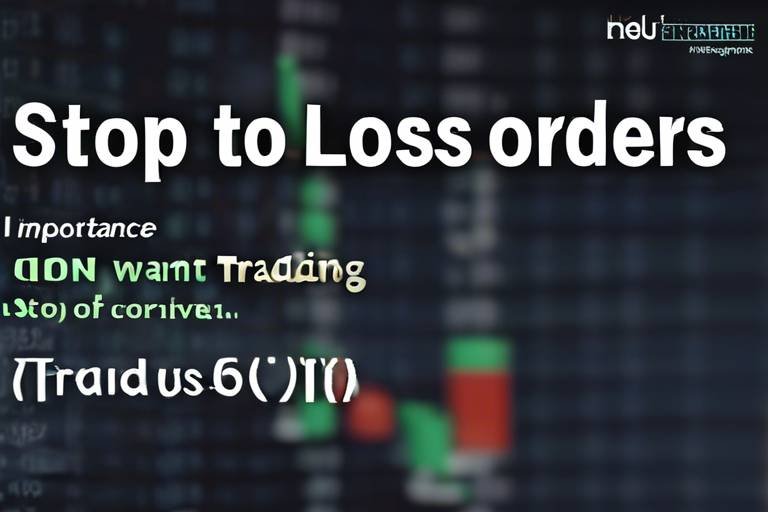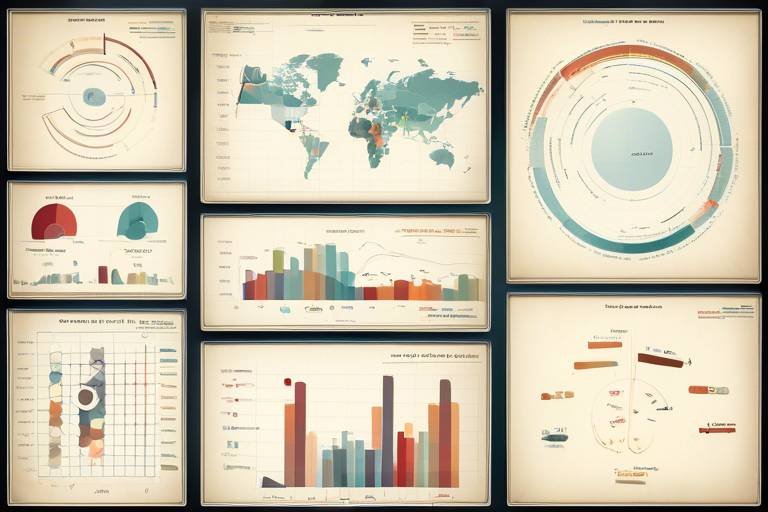How to Leverage Trend Analysis for Trading Success
In the fast-paced world of trading, understanding how to leverage trend analysis can be your secret weapon for success. Imagine walking into a bustling marketplace where prices fluctuate wildly. Wouldn't it be great to have a roadmap that guides you through the chaos? That's precisely what trend analysis does for traders. It provides a framework to evaluate historical price movements, allowing you to identify patterns and predict future price directions. By mastering this technique, you can make informed decisions that can significantly enhance your trading performance.
Trend analysis is not just about looking at a chart and guessing where the price will go next. It involves a systematic approach to understanding market behavior. Think of it as reading the pulse of the market; you’re not just observing what's happening now but also interpreting the signals that indicate where things might head in the future. This article will explore the significance of trend analysis, the different types of trends you might encounter, the tools available to assist you, and how to develop a robust trend-based strategy.
At its core, trend analysis is a technique used in trading to evaluate historical price movements. It helps traders identify patterns and predict future price directions, forming the basis for informed trading decisions. By analyzing past data, traders can discern whether a market is trending upwards, downwards, or moving sideways. This understanding is crucial because it allows traders to align their strategies with market movements, maximizing their potential for profit.
There are three primary types of trends that every trader should be aware of: upward trends, downward trends, and sideways trends. Understanding these trends is essential for developing strategies that align with market movements and maximizing profit potential.
An upward trend is characterized by prices consistently rising. Picture a mountain climber steadily ascending a peak; this is akin to how prices move in an upward trend. Recognizing this trend allows traders to capitalize on buying opportunities, enhancing their chances for profit as the market continues to ascend. The key is to identify the right moment to enter the market and ride the wave of rising prices.
Conversely, in a downward trend, prices are consistently falling, much like a leaf drifting down from a tree in autumn. Identifying this trend is crucial for traders looking to sell or short-sell, enabling them to take advantage of declining market conditions. By recognizing the signs of a downward trend, traders can position themselves strategically to profit from the downturn.
Sideways trends occur when prices move within a horizontal range, resembling a flat road that stretches out before you. Traders can utilize this trend to implement range-bound strategies, focusing on buying at support levels and selling at resistance levels. Understanding the boundaries of this trend is essential to avoid getting caught in a market that lacks clear direction.
To effectively conduct trend analysis, traders can employ various tools, including moving averages, trend lines, and technical indicators. Utilizing these tools can enhance accuracy in identifying and confirming trends, making your trading decisions more reliable.
Moving averages are a fundamental tool in trend analysis. They smooth out price data over specific periods, allowing traders to identify trends more clearly. Think of moving averages as a pair of glasses that help you see the market more clearly by filtering out the noise. By using moving averages, traders can recognize the direction of the market and make informed decisions based on the trends they observe.
Trend lines are another essential component of trend analysis. These lines are drawn on charts to connect significant price points, helping traders visualize trends and potential reversal points. They act as a guide, much like a compass, directing traders toward potential opportunities and warning them of possible pitfalls. By mastering the use of trend lines, traders can enhance their technical analysis skills and improve their trading outcomes.
Creating a strategy based on trend analysis involves setting entry and exit points, managing risk effectively, and aligning with market momentum. A well-defined strategy can lead to consistent trading success. It’s like crafting a recipe; you need the right ingredients and proportions to create something delicious.
Determining entry and exit points is critical in trend-based strategies. Traders should consider factors like support and resistance levels, ensuring they make informed decisions based on trend direction. Just like a seasoned chef knows when to add a pinch of salt, a trader must know when to enter or exit a trade to maximize their chances of success.
Effective risk management techniques, such as setting stop-loss orders and position sizing, are essential for protecting capital while trading based on trends. By implementing these strategies, traders can minimize losses in volatile markets and safeguard their investments. Think of risk management as wearing a seatbelt while driving; it’s a precaution that can save you from significant harm.
- What is trend analysis?
Trend analysis is a technique used to evaluate historical price movements to identify patterns and predict future price directions. - What are the types of trends?
The three primary types of trends are upward, downward, and sideways trends. - How can I identify trends in trading?
You can identify trends using tools like moving averages, trend lines, and technical indicators. - Why is risk management important in trading?
Risk management is crucial for protecting your capital and minimizing losses in volatile markets.

Understanding Trend Analysis
Trend analysis is a powerful technique used by traders to evaluate historical price movements in the financial markets. Think of it as a detective's magnifying glass, allowing traders to scrutinize past data to uncover patterns that can predict future price directions. By analyzing trends, traders can make informed decisions about when to enter or exit trades, ultimately enhancing their chances of success in a highly volatile environment.
At its core, trend analysis helps traders identify whether a market is moving up, down, or sideways. This understanding is crucial because it forms the basis for crafting effective trading strategies. For instance, if a trader identifies an upward trend, they might look for buying opportunities, while a downward trend could signal a good time to sell or short-sell. But how do traders effectively conduct trend analysis? The answer lies in understanding the various types of trends and employing the right tools to analyze them.
Moreover, trend analysis isn't just about looking at price charts; it's about interpreting the data to make strategic decisions. Traders often rely on historical data to identify recurring patterns, which can provide insights into future market behavior. This is similar to how meteorologists analyze weather patterns to forecast upcoming conditions. By studying trends, traders can better predict potential market movements and adjust their strategies accordingly.
In addition to recognizing trends, traders can enhance their analysis by utilizing tools and indicators that provide further clarity. For example, moving averages can help smooth out price fluctuations, making it easier to spot the overall direction of a trend. Similarly, trend lines drawn on charts connect significant price points, allowing traders to visualize trends and potential reversal points more effectively.
In conclusion, understanding trend analysis is essential for any trader looking to navigate the complex world of financial markets. By identifying trends and utilizing effective tools, traders can make informed decisions that align with market movements, ultimately leading to greater trading success. So, whether you're a novice or an experienced trader, mastering trend analysis can be your secret weapon in achieving your trading goals.
- What is trend analysis?
Trend analysis is the evaluation of historical price movements to identify patterns that can predict future price directions.
- Why is trend analysis important in trading?
It helps traders make informed decisions regarding entry and exit points, which can significantly impact trading success.
- What are the main types of trends?
The three primary types of trends are upward, downward, and sideways.
- What tools can assist in trend analysis?
Common tools include moving averages, trend lines, and various technical indicators.
- How can I develop a trend-based trading strategy?
By identifying entry and exit points, implementing risk management techniques, and aligning with market momentum.

Types of Trends
When it comes to trading, understanding the is like having a map in an unfamiliar territory. Trends can be classified into three primary categories: upward, downward, and sideways. Each type of trend tells a different story about the market's behavior, and recognizing these patterns is crucial for traders aiming to make informed decisions.
An upward trend is characterized by prices consistently moving higher over time. Imagine a mountain peak; traders on this upward slope are looking to capitalize on the rising prices, buying in before the market reaches its zenith. This trend often attracts bullish sentiment, where traders feel optimistic about future price movements. The key here is to identify when the trend is established, as getting in early can significantly enhance profit potential.
On the flip side, a downward trend indicates that prices are on a consistent decline. Picture a waterfall cascading down; traders who recognize this trend are looking to either sell their positions or short-sell, benefiting from the downward movement. Timing is everything in a downward trend, as traders need to be vigilant to avoid getting caught in a reversal. Understanding the market's psychology during this phase can provide insights into when to act.
Lastly, we have sideways trends, which occur when prices fluctuate within a horizontal range. Think of it like a calm sea where the waves are minimal; traders can take advantage of this stability by implementing range-bound strategies. In a sideways market, traders often look for opportunities to buy at support levels and sell at resistance levels. It's a bit like playing a game of tug-of-war, where knowing when to pull back or push forward can lead to successful trades.
To summarize, recognizing these three types of trends is essential for any trader. Each trend offers unique opportunities and challenges, and understanding them can significantly impact trading success. Here’s a quick overview:
| Trend Type | Description | Trading Strategy |
|---|---|---|
| Upward Trend | Prices are consistently rising. | Buy on dips to maximize profit. |
| Downward Trend | Prices are consistently falling. | Sell or short-sell to profit from declines. |
| Sideways Trend | Prices move within a horizontal range. | Buy at support, sell at resistance. |
Understanding these trends not only enhances a trader's ability to make informed decisions but also helps in developing strategies that align with market movements. So, whether you’re riding the waves of an upward trend or navigating the calm of a sideways market, recognizing these patterns is your ticket to trading success!
- What is trend analysis? Trend analysis is a method used to evaluate historical price movements to predict future price directions.
- How can I identify an upward trend? Look for higher highs and higher lows in price movements over a specified period.
- What tools can help in trend analysis? Useful tools include moving averages, trend lines, and various technical indicators.
- Is it possible to trade successfully without understanding trends? While it’s possible, understanding trends significantly enhances your chances of making informed and profitable trades.

Upward Trends
When we talk about , we're diving into a world where prices are on a consistent rise, like a hot air balloon soaring into the sky. This is the kind of trend that traders dream about because it presents a plethora of buying opportunities. Imagine standing at the bottom of a mountain, looking up at the peak. The upward trend is your path to the summit, guiding you toward potential profits as you make your way up. Recognizing this trend is crucial, as it allows traders to position themselves effectively in the market.
So, how do you spot an upward trend? It's not just about looking for higher highs and higher lows; it’s about understanding the underlying momentum driving the market. Here are some signs that indicate an upward trend:
- Higher Highs: Each peak in price is higher than the last, signaling strong buying interest.
- Higher Lows: The dips are not as deep, suggesting that sellers are less aggressive.
- Volume Increase: A rise in trading volume often accompanies price increases, confirming the trend's strength.
Utilizing tools like moving averages can further enhance your ability to identify and confirm these trends. For instance, the 50-day moving average crossing above the 200-day moving average is often referred to as a 'golden cross' and is a classic indicator of a potential upward trend. But remember, even in the most bullish markets, corrections can happen. So, having a strategy in place to manage your trades is essential.
In an upward trend, traders often employ various strategies to maximize their gains. Some common approaches include:
- Trend Following: This involves buying stocks or assets that are already in an upward trend, with the expectation that they will continue to rise.
- Breakout Trading: Traders look for price levels that, once breached, can lead to further upward movement.
- Scaling In: Gradually increasing your position as the price moves in your favor can help mitigate risk.
In summary, upward trends are a trader’s best friend, offering a chance to ride the wave of rising prices. By recognizing the signs and employing effective strategies, you can enhance your chances of success in the market. But always remember, the market can be unpredictable, and staying informed and adaptable is key to thriving in any trading environment.
Q: How do I identify an upward trend?
A: Look for higher highs and higher lows in price movements, along with increasing trading volume. Tools like moving averages can also help confirm the trend.
Q: What should I do if I spot an upward trend?
A: Consider entering a position, but ensure you have a strategy in place for managing your risk and setting exit points.
Q: Can upward trends reverse?
A: Yes, upward trends can reverse. It’s crucial to stay vigilant and watch for signs of trend exhaustion or market corrections.

Downward Trends
In the world of trading, recognizing is akin to spotting a storm on the horizon. Just as sailors prepare for rough seas, traders must be equipped to navigate the turbulent waters of a market that is consistently falling. A downward trend is characterized by a series of lower highs and lower lows, indicating that prices are on a decline. This trend can be a goldmine for those who know how to leverage it effectively.
Identifying a downward trend is crucial because it opens up opportunities for traders to sell or even engage in short-selling. When the market is in a downward spiral, the potential for profit exists for those who can anticipate further declines. Imagine you’re riding a wave; the key is to catch it at the right moment. In a downward trend, that means entering your trades when the momentum is clearly in your favor.
To better understand how to capitalize on downward trends, consider the following key indicators:
- Lower Highs and Lower Lows: This is the most straightforward way to identify a downward trend. If you see this pattern forming, it’s a signal that the market sentiment is bearish.
- Volume Analysis: Often, a downward trend is accompanied by increasing trading volume, which can validate the strength of the trend. Higher volume during price declines suggests strong selling pressure.
- Technical Indicators: Tools like the Moving Average Convergence Divergence (MACD) or the Relative Strength Index (RSI) can provide valuable insights. An RSI below 30 might indicate an oversold condition, but it’s essential to consider the overall trend before jumping in.
Traders can also implement various strategies to maximize their success in downward trends. For instance, using stop-loss orders is crucial to protect against unexpected reversals. Just like wearing a seatbelt in a car, these orders can save you from significant losses if the market turns against you. Furthermore, understanding support and resistance levels can provide insight into where the price might stabilize or bounce back, offering additional trading opportunities.
In conclusion, mastering the art of trading in a downward trend requires a keen eye and a well-thought-out strategy. It’s about being proactive rather than reactive, ensuring that you’re not just surviving the storm but thriving in it. By recognizing the signs of a downward trend and employing effective trading strategies, you can turn potential losses into profits, making the most of what the market has to offer.

Sideways Trends
Sideways trends, often referred to as range-bound markets, are fascinating phenomena in the trading world. Imagine a game of tug-of-war where neither side can gain the upper hand; that's precisely what happens in a sideways trend. Prices oscillate within a defined range, moving neither significantly up nor down. This creates a unique environment for traders, as they can exploit the predictable nature of these movements.
In a sideways trend, the market tends to establish clear support and resistance levels. Support is the price level where buying interest is strong enough to prevent the price from falling further, while resistance is the level where selling interest is sufficient to stop the price from rising. Recognizing these levels can be incredibly beneficial for traders, as they can make informed decisions about when to enter or exit trades.
For instance, consider the following table that illustrates how prices might behave within a sideways trend:
| Time Period | Price Action |
|---|---|
| Week 1 | Price bounces between $50 and $55 |
| Week 2 | Price bounces between $51 and $54 |
| Week 3 | Price remains stable around $52 |
Traders can utilize these support and resistance levels to implement range-bound strategies. For example, when the price approaches the support level, traders might consider it a buying opportunity, while a price nearing the resistance level could signal a selling opportunity. This strategy can be particularly effective in sideways markets, where the lack of directional movement offers a consistent rhythm to trading.
However, it's essential to remain vigilant. Sideways trends can sometimes precede significant price movements. A sudden breakout above resistance or below support can signal the start of a new trend, which could lead to substantial trading opportunities—or risks. Therefore, traders must always be prepared to adjust their strategies in response to market changes.
In summary, while sideways trends might seem less exciting than upward or downward trends, they offer unique opportunities for traders willing to adapt. By identifying support and resistance levels and employing strategic trading methods, traders can thrive even in these seemingly stagnant markets.
- What is a sideways trend? A sideways trend occurs when prices move within a horizontal range, showing little upward or downward movement.
- How can I identify support and resistance levels? Support and resistance levels can be identified by analyzing historical price data and observing where prices have previously reversed direction.
- What strategies work best in a sideways market? Range-bound strategies, which involve buying at support and selling at resistance, are typically effective in sideways markets.
- Can sideways trends lead to significant market movements? Yes, sideways trends can often precede breakouts, leading to new upward or downward trends.

Tools for Trend Analysis
When it comes to mastering the art of trading, having the right tools at your disposal is essential. Trend analysis is no exception. The effectiveness of your trading strategy can significantly improve when you utilize various analytical tools designed to help you identify and confirm market trends. Among the most popular tools are moving averages, trend lines, and a variety of technical indicators. Each of these tools serves a unique purpose and can be combined for a more comprehensive view of market movements.
Moving averages are one of the most widely used tools in trend analysis. They help traders smooth out price data over a specific time frame, allowing for a clearer understanding of the overall direction of the market. For instance, a simple moving average (SMA) calculates the average price over a set number of periods, which can help filter out the noise of daily price fluctuations. When a short-term moving average crosses above a long-term moving average, it often signals a potential upward trend, while the opposite situation might indicate a downward trend.
Another valuable tool is the trend line. By drawing lines on a price chart that connect significant price points, traders can visualize the direction of a trend. Trend lines help in identifying potential reversal points, which can be crucial for making informed trading decisions. For example, an upward trend line connects the lows of an ascending price movement, while a downward trend line connects the highs of a descending price movement. The interaction of price with these lines can provide insights into market sentiment and potential future movements.
In addition to moving averages and trend lines, traders often employ technical indicators such as the Relative Strength Index (RSI) or Moving Average Convergence Divergence (MACD). These indicators can provide additional confirmation of trends and help traders make more informed decisions. The RSI, for instance, measures the speed and change of price movements, indicating whether a market is overbought or oversold. Meanwhile, the MACD helps identify changes in the strength, direction, momentum, and duration of a trend, providing crucial insights for traders looking to enter or exit positions.
| Tool | Purpose | Benefits |
|---|---|---|
| Moving Averages | Smooth out price data | Helps identify trends and filter noise |
| Trend Lines | Visualize price movements | Indicate potential reversal points |
| Technical Indicators | Provide additional trend confirmation | Enhance decision-making accuracy |
In conclusion, leveraging these tools can significantly enhance your trend analysis capabilities. By combining moving averages, trend lines, and technical indicators, you can develop a more robust trading strategy that aligns with market movements. Remember, the key to successful trading lies in making informed decisions based on comprehensive analysis. So, equip yourself with these tools, and watch your trading game reach new heights!
- What is the best tool for trend analysis? Each tool has its strengths. Moving averages are great for smoothing price data, while trend lines help visualize market movements and potential reversals. A combination of these tools often yields the best results.
- How do I know when to use technical indicators? Technical indicators are best used when you want to confirm trends or identify potential entry and exit points. They are particularly useful in volatile markets.
- Can I rely solely on trend analysis for trading? While trend analysis is a powerful tool, it should be part of a broader trading strategy that includes risk management and fundamental analysis.

Moving Averages
are one of the most popular tools in the trader's toolbox, serving as a fundamental method for analyzing price trends over specific periods. Think of moving averages as a way to smooth out the wild fluctuations in price data, providing a clearer picture of the overall direction of the market. By averaging the price over a set number of days, traders can filter out the noise and focus on the underlying trend. This is particularly useful in a world where prices can swing dramatically from one moment to the next, making it hard to see the forest for the trees.
There are two primary types of moving averages that traders commonly use: the Simple Moving Average (SMA) and the Exponential Moving Average (EMA). The SMA calculates the average of a set number of prices over a specified period, giving equal weight to all prices in that range. On the other hand, the EMA gives more weight to recent prices, making it more responsive to new information. This responsiveness can be a double-edged sword; while it can help traders catch trends earlier, it may also lead to false signals during volatile market conditions.
To provide a clearer understanding, here's a quick comparison table:
| Type | Calculation Method | Responsiveness | Best Use Case |
|---|---|---|---|
| Simple Moving Average (SMA) | Averages all prices equally over a set period | Less responsive | Long-term trend analysis |
| Exponential Moving Average (EMA) | Gives more weight to recent prices | More responsive | Short-term trading |
Traders often use moving averages in conjunction with other indicators to confirm trends. For instance, if the price crosses above the SMA, it may signal a bullish trend, while a cross below could indicate a bearish trend. This crossover technique can be a powerful strategy for entry and exit points. However, it’s essential to remember that no tool is foolproof. Just like a compass can point you in the right direction, it’s still up to you to navigate the terrain. Therefore, combining moving averages with other technical indicators, such as the Relative Strength Index (RSI) or MACD, can enhance the robustness of your trading strategy.
In summary, moving averages are a vital component of trend analysis in trading. They not only help in identifying the direction of the market but also assist in making informed decisions. By understanding the differences between SMA and EMA, traders can choose the right type of moving average that aligns with their trading style and objectives.
- What is the main purpose of using moving averages in trading? Moving averages help traders identify trends and potential reversal points by smoothing out price data over time.
- How do I choose between SMA and EMA? If you prefer a more stable and less reactive indicator, the SMA is suitable for long-term trends. For short-term trading that requires quick reactions, the EMA is more effective.
- Can moving averages guarantee success in trading? No, while moving averages are helpful tools, they should be used in conjunction with other indicators and strategies to improve accuracy and reduce risks.

Trend Lines
Trend lines are one of the most fundamental tools in a trader's toolkit, acting as a visual guide to understanding market direction. By connecting significant price points on a chart, trend lines help traders identify the prevailing trend, whether it's upward, downward, or sideways. They serve as a roadmap, allowing traders to navigate the often turbulent waters of financial markets with a clearer vision.
To draw a trend line, you start by identifying at least two significant price points. For an upward trend, you would connect the lowest points (or troughs) on the chart, while for a downward trend, you connect the highest points (or peaks). The more points you connect, the stronger the trend line becomes. This is because a trend line that has been touched multiple times indicates a more reliable level of support or resistance.
But why are trend lines so critical? Well, they help traders make informed decisions by providing insight into potential reversal points. For instance, if the price approaches a trend line and shows signs of bouncing back, it may indicate a continuation of the trend. Conversely, if the price breaks through a trend line, it could signal a reversal, prompting traders to reassess their positions.
Moreover, trend lines can be used in conjunction with other technical indicators to enhance trading strategies. For example, combining trend lines with moving averages can provide additional confirmation of a trend's strength. When a price crosses above a moving average and also touches an upward trend line, it creates a compelling case for a buying opportunity.
However, it’s essential to remember that trend lines are not infallible. They are subject to interpretation, and different traders may draw them differently. This subjectivity can lead to varying conclusions about market direction. Therefore, it’s crucial to use trend lines as part of a broader trading strategy that includes risk management and other analytical tools.
In summary, trend lines are a powerful aspect of technical analysis. They not only help visualize market trends but also assist in identifying potential entry and exit points. By mastering the art of drawing and interpreting trend lines, traders can significantly enhance their trading acumen and improve their chances of success in the market.
- What is a trend line? A trend line is a straight line drawn on a chart that connects significant price points, helping traders identify the direction of the market.
- How do I draw a trend line? To draw a trend line, connect at least two significant price points on a chart. For upward trends, connect the lows; for downward trends, connect the highs.
- Are trend lines always accurate? No, trend lines are subject to interpretation and can vary between traders. They should be used in conjunction with other analytical tools for better accuracy.
- Can trend lines indicate reversal points? Yes, when the price approaches a trend line and shows signs of bouncing back, it may indicate a continuation of the trend. A break through a trend line may signal a reversal.

Developing a Trend-Based Strategy
Creating a successful trading strategy based on trend analysis is like crafting a fine recipe; it requires the right ingredients and precise measurements. First and foremost, you need to set clear entry and exit points. These points are your guideposts, helping you navigate the often turbulent waters of the market. Think of them as the North Star for your trading journey. To determine these points, consider significant support and resistance levels. Support levels are where prices tend to bounce back up, while resistance levels are where prices often hit a ceiling and fall back down. Understanding these levels can help you make informed decisions that align with the market's direction.
Next, let's talk about risk management techniques. Imagine you're a captain steering a ship through stormy seas; you wouldn't set sail without a life jacket, right? In trading, your life jacket is your risk management strategy. Techniques such as setting stop-loss orders and determining your position size are essential for protecting your capital. A stop-loss order automatically sells your assets when they reach a certain price, minimizing potential losses. Position sizing, on the other hand, helps you determine how much of your capital to allocate to each trade, ensuring you don’t overexpose yourself to risk.
Moreover, aligning your strategy with market momentum is crucial. This means keeping an eye on the overall market trends and adjusting your trades accordingly. For instance, if you identify a strong upward trend, you might want to focus on buying opportunities, whereas a downward trend might prompt you to consider short-selling. The key is to remain flexible and responsive to market changes, much like a skilled dancer who adapts to the rhythm of the music.
To summarize, developing a trend-based strategy involves a combination of setting entry and exit points, implementing effective risk management techniques, and aligning with market momentum. Each of these elements plays a vital role in your trading success. By following this structured approach, you can enhance your decision-making process and increase your chances of achieving consistent profits in the ever-evolving world of trading.
- What is trend analysis? Trend analysis is a technique used to evaluate historical price movements to identify patterns and predict future price directions.
- How do I identify an upward trend? An upward trend is characterized by consistently rising prices. Look for higher highs and higher lows on the price chart.
- What tools can I use for trend analysis? Tools such as moving averages, trend lines, and various technical indicators can assist in identifying trends effectively.
- Why is risk management important in trading? Risk management is crucial because it helps protect your capital from significant losses, allowing you to trade more confidently.
- How often should I review my trading strategy? Regularly reviewing your trading strategy is essential, especially after significant market movements or changes in trend direction.

Entry and Exit Points
Determining is critical in trend-based strategies. Think of it as navigating through a forest; if you don't know where you're going in, you might end up lost or, worse, stuck in a thicket! Similarly, in trading, pinpointing the right moments to enter or exit a position can make all the difference between profit and loss.
When considering entry points, traders often look for signs that confirm the direction of the trend. For instance, if you identify an upward trend, you might want to enter when the price pulls back to a support level. This is like waiting for the perfect wave before you jump into the surf. You want to ride the wave at just the right moment to maximize your gains.
On the other hand, exit points are equally essential. These are the moments when you decide to take your profits or cut your losses. Setting exit points can be influenced by various factors, such as support and resistance levels, or using trailing stops to lock in profits as the price moves in your favor. Think of it like running a marathon; you need to know when to pace yourself and when to sprint toward the finish line.
Here are some key considerations when establishing entry and exit points:
- Support and Resistance Levels: Identify historical price levels where the market has reversed. These can serve as potential entry or exit points.
- Market Momentum: Pay attention to the strength of the trend. A strong upward momentum might suggest holding on longer, while weakening momentum could indicate it's time to exit.
- Technical Indicators: Utilize indicators like the Relative Strength Index (RSI) or Moving Average Convergence Divergence (MACD) to help confirm your entry and exit decisions.
Incorporating these factors into your trading plan will enhance your ability to make informed decisions. Remember, trading is not just about the numbers; it's about understanding the market psychology behind those numbers. By mastering your entry and exit points, you can navigate the trading landscape with more confidence and clarity.
What are entry and exit points in trading?
Entry and exit points refer to the specific prices at which a trader decides to buy or sell an asset. Identifying these points is crucial for maximizing profits and minimizing losses.
How do I determine the best entry point?
The best entry point can be determined by analyzing support levels, market momentum, and using technical indicators to confirm the trend direction.
What is the significance of exit points?
Exit points are significant because they help traders lock in profits or cut losses at the right time, ensuring that they do not lose potential gains when the market turns against them.
Can I use stop-loss orders to manage exit points?
Absolutely! Stop-loss orders are an effective way to manage your exit points, allowing you to automatically sell an asset when it reaches a predetermined price, thus limiting your losses.

Risk Management Techniques
This article explores the significance of trend analysis in trading, detailing methods to identify trends, tools to use, and strategies to enhance trading success through informed decision-making.
Trend analysis is a technique used in trading to evaluate historical price movements. It helps traders identify patterns and predict future price directions, forming the basis for informed trading decisions.
There are three primary types of trends: upward, downward, and sideways. Understanding these trends is essential for traders to develop strategies that align with market movements and maximize profit potential.
An upward trend indicates that prices are consistently rising. Recognizing this trend allows traders to capitalize on buying opportunities, enhancing their chances for profit as the market continues to ascend.
In a downward trend, prices are consistently falling. Identifying this trend is crucial for traders looking to sell or short-sell, enabling them to take advantage of declining market conditions.
Sideways trends occur when prices move within a horizontal range. Traders can utilize this trend to implement range-bound strategies, focusing on buying at support levels and selling at resistance levels.
Various tools assist traders in conducting trend analysis, including moving averages, trend lines, and technical indicators. Utilizing these tools can enhance accuracy in identifying and confirming trends.
Moving averages smooth out price data to identify trends over specific periods. They help traders recognize the direction of the market and filter out market noise, providing clearer signals for trading decisions.
Trend lines are drawn on charts to connect significant price points. They help traders visualize trends and potential reversal points, making them a valuable tool for technical analysis.
Creating a strategy based on trend analysis involves setting entry and exit points, risk management, and aligning with market momentum. A well-defined strategy can lead to consistent trading success.
Determining entry and exit points is critical in trend-based strategies. Traders should consider factors like support and resistance levels, ensuring they make informed decisions based on trend direction.
Effective risk management techniques are the backbone of successful trading, especially when leveraging trend analysis. Without these techniques, even the best trading strategies can lead to significant losses. One fundamental aspect is setting stop-loss orders. A stop-loss order automatically sells a security when it reaches a certain price, minimizing potential losses. By determining a stop-loss level based on market volatility or support levels, traders can protect their capital from unexpected market swings.
Another essential technique is position sizing. This involves deciding how much capital to allocate to each trade based on the trader's overall portfolio and risk tolerance. A common rule of thumb is to risk no more than 1-2% of your trading capital on a single trade. This ensures that even a series of losses won’t significantly impact your overall trading account.
Additionally, traders should regularly assess their trades and adjust their strategies accordingly. Maintaining a trading journal can be beneficial for tracking performance and identifying patterns in successful and unsuccessful trades. This reflection allows for continual improvement and adaptation to changing market conditions.
In summary, effective risk management is not just about limiting losses; it’s about creating a sustainable trading approach that allows traders to remain in the game over the long haul. By incorporating techniques like stop-loss orders, position sizing, and ongoing evaluation, traders can navigate the complexities of the market with greater confidence.
- What is trend analysis? Trend analysis is a method used by traders to evaluate historical price movements and predict future price directions, helping them make informed trading decisions.
- Why is risk management important in trading? Risk management is crucial as it helps traders protect their capital, minimize losses, and ensure long-term sustainability in their trading activities.
- How can I identify upward and downward trends? Traders can identify upward trends by looking for higher highs and higher lows in price movements, while downward trends are characterized by lower highs and lower lows.
- What tools can assist in trend analysis? Common tools include moving averages, trend lines, and various technical indicators that help traders visualize and confirm trends.
Frequently Asked Questions
- What is trend analysis in trading?
Trend analysis is a method used by traders to evaluate historical price movements in order to identify patterns. By analyzing these trends, traders can make informed predictions about future price directions, which is essential for successful trading.
- What are the different types of trends?
There are three primary types of trends in trading: upward, downward, and sideways. Upward trends indicate rising prices, downward trends show falling prices, and sideways trends occur when prices move within a horizontal range. Understanding these trends helps traders develop effective strategies.
- How can I identify an upward trend?
An upward trend is identified by consistently rising prices over time. Traders can use tools like moving averages and trend lines to visualize and confirm these trends, allowing them to capitalize on buying opportunities.
- What tools are useful for trend analysis?
Several tools can assist in trend analysis, including moving averages, trend lines, and various technical indicators. These tools help traders filter out market noise and provide clearer signals for making trading decisions.
- How do moving averages help in trading?
Moving averages smooth out price data over specific periods, helping traders to identify the overall direction of the market. They are particularly useful for filtering out short-term fluctuations and focusing on longer-term trends.
- What is the importance of entry and exit points in trading?
Determining entry and exit points is crucial for successful trading strategies. Traders should analyze support and resistance levels to make informed decisions, ensuring they enter and exit trades at optimal times based on trend direction.
- What are some effective risk management techniques?
Effective risk management techniques include setting stop-loss orders and determining appropriate position sizes. These strategies help traders protect their capital and minimize losses, especially in volatile market conditions.


















